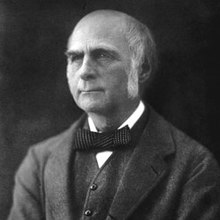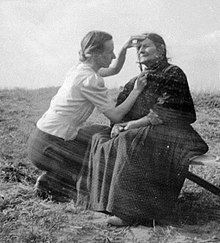Racial hygiene

Racial hygiene was a set of state-sanctioned policies in the early twentieth century by which certain groups of individuals were allowed to procreate and others not, with the expressed purpose of promoting characteristics deemed desirable. The most extensive implementation of such policies occurred in Nazi Germany (Nazi eugenics), but similar policies were implemented throughout Europe, North America, and Southern Africa. [citation needed]
The concept of racial purity was developed by Arthur de Gobineau, who argued that race created culture and that race-mixing leads to chaos. Racial hygiene was historically tied to traditional notions of public health, but usually with an enhanced emphasis on heredity. Francis Galton began working in 1869 to find a statistical science of heredity which he believed could encourage voluntary care in selecting partners, and in 1883 he introduced the term "eugenics" for this subject, but in the early 20th century a eugenics movement adopted ideas of Mendelian genetics and promoted negative eugenics to prevent those thought to be unsuitable from having children, and eugenics was used to legitimise policies of racial hygiene.
In Germany

The German eugenicist Alfred Ploetz introduced the term Rassenhygiene in his "Racial hygiene basics" (Grundlinien einer Rassenhygiene) in 1895. In its earliest incarnation it was concerned more with the declining birthrate of the German state and the increasing number of mentally ill and disabled people in state-run institutions (and their costs to the state) than with the "Jewish question" and "degeneration of the Nordic race" (Entnordung) which would come to dominate its philosophy in Germany from the 1920s through the second World War.

In Nazi propaganda the term "race" was often interchangeably used to describe and mean the "Aryan" or Germanic "Übermenschen" which was said to represent an ideal and pure master race that was biologically superior to all other races.[1] In the 1930s, under eugenicist Ernst Rüdin, National Socialist ideology embraced this latter use of "racial hygiene", which demanded Aryan racial purity and condemned miscegenation. This belief in the importance of German racial purity often served as the theoretical backbone of Nazi policies of racial superiority and later genocide. These policies began in 1935, when the National Socialists enacted the Nuremberg Laws, which legislated racial purity by forbidding sexual relations and marriages between Aryans and non-Aryans as Rassenschande (racial shame).
A key part of National Socialism was the concept of racial hygiene and during their rule the field was elevated to the primary philosophy of the German medical community, first by activist physicians within the medical profession, particularly amongst psychiatrists. This was later codified and institutionalized during and after the Nazis' rise to power in 1933, during the process of Gleichschaltung (literally, "coordination" or "unification") which streamlined the medical and mental hygiene (mental health) profession into a rigid hierarchy with National Socialist-sanctioned leadership at the top.[2]
The blueprint for Nazism's attitude toward other races was written by Erwin Baur, Fritz Lenz, and Eugen Fischer and published under the title Human Heredity Theory and Racial Hygiene (1936).
Racial hygienists played key roles in the Holocaust, the National Socialist effort to purge Europe of Jews, Romani people, Poles, Serbs, Ukrainians, Russians, mixed race, black people, homosexuals, trans people, political dissidents, the mentally retarded, and the insane. The precursors for this were earlier medical experimentation on African prisoners of war in concentration camps in Namibia during the Herero and Namaqua Genocide.[3]
After World War II
After World War II, the racialist ideology was denounced as unscientific and pseudoscience by many,[4] although there continued to be supporters of eugenics even after there was widespread awareness of the Nazi debacle. Post 1945 eugenics proponents include Julian Huxley and Dr. Marie Stopes.[5]
See also
- Action T4
- Endogamy
- Ethnic cleansing
- Eugenics in Japan
- Eugenics in the United States
- Euthanasia
- Genetic pollution, a controversial term because of its similar connotations
- Mental hygiene
- Miscegenation (in humans), Outcrossing (in non-human organisms)
- Pure blood theory in Korea
- Purebred
- Racial policy of Nazi Germany
- Race (human classification)
- Race of the future - a theoretical composite world race which will result from ongoing racial admixture
- Rassenschande
- White supremacy
References
- ^ Peter Longerich (15 April 2010). Holocaust: The Nazi Persecution and Murder of the Jews. Oxford University Press. p. 30. ISBN 978-0-19-280436-5.
- ^ Herzog, Dagmar (2005). Sexuality and German Fascism. Berghahn Books. p. 167.
- ^ Lusane, Clarence (2002-12-13). "Hitler's black victims: The historical experiences of Afro-Germans, European Blacks, Africans, and African Americans in the Nazi era". ISBN 9780415932950.
{{cite journal}}: Cite journal requires|journal=(help) - ^ Wentz S, Proctor RN, Weiss SF (1989). "Racial hygiene: the pseudo-science of Nazi medicine". Medical Humanities Review. 3 (1): 13–8. PMID 11621731.
- ^ Rose, June (1993). Marie Stopes and the Sexual Revolution. London: Faber and Faber. p. 244.
Further reading
- Glad, John. (2008). Future Human Evolution: Eugenics in the Twenty-First Century. Hermitage Publishers.
- Joseph, J. (2004). The Gene Illusion: Genetic Research in Psychiatry and Psychology Under the Microscope. New York: Algora. (2003 United Kingdom Edition by PCCS Books)
- Joseph, J. (2006). The Missing Gene: Psychiatry, Heredity, and the Fruitless Search for Genes. New York: Algora.
- Paul, Diane B. Controlling Human Heredity, 1865 to the Present. New Jersey: Humanities Press, 1995.
- Proctor, Robert. Racial Hygiene: Medicine Under the Nazis. Cambridge, Mass.: Harvard University Press, 1988.
